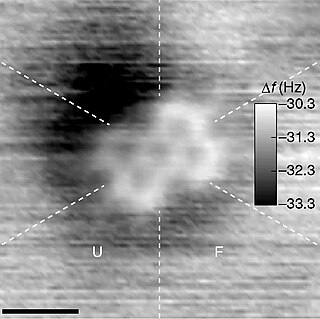The molecular formula C9H18O (molar mass: 142.24 g/mol) may refer to:
- Nonanal
- Nonanones
- 2-Nonanone
- 3-Nonanone
- 4-Nonanone
- 5-Nonanone, or dibutyl ketone
- 3,3,5-Trimethylcyclohexanol
The molecular formula C9H18O (molar mass: 142.24 g/mol) may refer to:
A chemical formula is a way of presenting information about the chemical proportions of atoms that constitute a particular chemical compound or molecule, using chemical element symbols, numbers, and sometimes also other symbols, such as parentheses, dashes, brackets, commas and plus (+) and minus (−) signs. These are limited to a single typographic line of symbols, which may include subscripts and superscripts. A chemical formula is not a chemical name, and it contains no words. Although a chemical formula may imply certain simple chemical structures, it is not the same as a full chemical structural formula. Chemical formulae can fully specify the structure of only the simplest of molecules and chemical substances, and are generally more limited in power than chemical names and structural formulae.
In chemistry, the empirical formula of a chemical compound is the simplest whole number ratio of atoms present in a compound. A simple example of this concept is that the empirical formula of sulfur monoxide, or SO, would simply be SO, as is the empirical formula of disulfur dioxide, S2O2. Thus, sulfur monoxide and disulfur dioxide, both compounds of sulfur and oxygen, have the same empirical formula. However, their molecular formulas, which express the number of atoms in each molecule of a chemical compound, are not the same.

A molecule is a group of two or more atoms held together by attractive forces known as chemical bonds; depending on context, the term may or may not include ions which satisfy this criterion. In quantum physics, organic chemistry, and biochemistry, the distinction from ions is dropped and molecule is often used when referring to polyatomic ions.
Benzol may refer to:

In science, a formula is a concise way of expressing information symbolically, as in a mathematical formula or a chemical formula. The informal use of the term formula in science refers to the general construct of a relationship between given quantities.

Casomorphin is an opioid peptide derived from the digestion of the milk protein casein.
The molecular formula C6H6 (molar mass: 78.114)
The molecular formula C9H13NO3 (molar mass: 183.20 g/mol, exact mass: 183.089543) may refer to:
The molecular formula C3H6O3 may refer to:
The molecular formula C5H9N3 (molar mass: 111.15 g/mol, exact mass: 111.0796 u) may refer to:
The molecular formula C9H8O4 (molar mass: 180.15 g/mol, exact mass: 180.0423 u) may refer to:
Dihydroxybenzoic acids (DHBA) are a type of phenolic acids.
Dioxin may refer to:
Dihydroxycinnamic acid may refer to several molecules with the molecular formula C9H8O4 including:
Octynes are alkynes with one triple bond and the molecular formula C8H14.
Nonynes are alkynes with one triple bond and the molecular formula C9H16.
Decynes are alkynes with one triple bond and the molecular formula C10H18.
The molecular formula C6H4O5 may refer to:
5-Nonanone, or dibutyl ketone, is the organic compound with the formula (CH3CH2CH2CH2)2CO. This colorless liquid is a symmetrical ketone.
Heptynes are alkynes with one triple bond and the molecular formula C7H12.